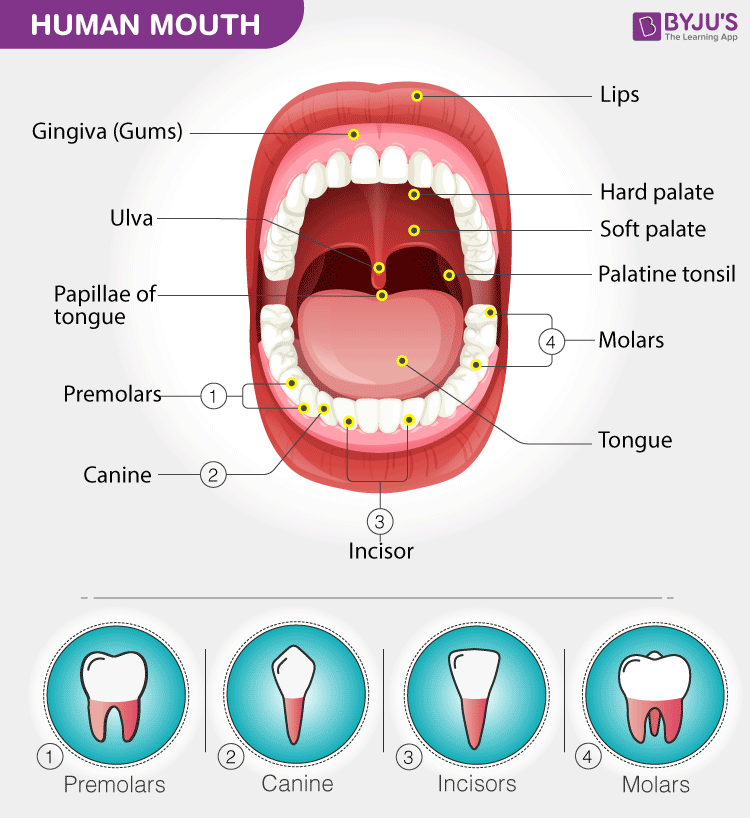The mouth is also known as the buccal cavity or oral cavity. It includes the lips, cheeks and palate. It also encloses the tongue, teeth and salivary glands. The mouth anteriorly opens outside via the lips and posteriorly opens via the fauces (throat) into the pharynx.
Here, let us learn more about the structures present in the human mouth with the help of a diagram.
Labelled Diagram of Mouth

Human Mouth – Description
- The mouth or oral cavity is the beginning of the human digestive system, and it can be divided into 2 portions – the oral vestibule and the oral cavity proper. The vestibule comprises the lips, cheeks and teeth. The oral cavity proper includes the tongue.
- The first visible portion is the lips which are soft, movable structures that contain melanocytes. The lips are demarcated from the adjacent normal skin by a vermillion border. This border of the upper lip portion is termed the cupid’s bow.
- The mouth is bounded at the front and the sides by alveolar bones that contain the teeth. At the back, it is bounded by an oropharyngeal isthmus ((isthmus of the fauces).
- Between the tooth row of the lower jaw (mandible), there is a tongue covered with numerous papillae. They contain taste buds.
- The upper jaw is termed the maxilla, and the lower jaw is called the mandible in vertebrates. It is covered by mucosal tissue called the gingiva or gums. These soft tissues provide a seal around the teeth.
- The human mouth shows heterodont dentition, i.e., the teeth vary structurally and are adapted to handle food in different ways. The teeth are, therefore, classified as incisors, canines, premolars, and molars.
- The salivary glands are present behind and under the jaw. There are also many other tiny salivary glands in the cheek, lips and other areas of the mouth. The saliva is mainly secreted by 3 pairs of major salivary glands (parotid, submaxillary and sublingual) and some minor salivary glands.
- The oral mucosa (mucous membrane) lines the inside of the mouth, and it receives secretions from the salivary glands.
- The term palate refers to the mouth roof that forms a division between the oral and nasal cavities. The palate comprises 2 portions – the hard palate and the soft palate. The former forms the anterior 4/5th of the palate, and the latter forms the posterior 1/5th portion.
- The soft palate or velum does not contain bone like the hard palate.
- The palatine uvula is a conical projection of the soft palate. The movement of the bolus into the upper portion of the pharynx (nasopharynx) is prevented by the soft palate along with its conical extension known as the uvula.
- There are two almond-shaped tonsils (palatine tonsils) present in the lateral wall of the oropharynx (isthmus of the fauces).
Most of these structures are named in relation to the palate, tongue, lips and cheeks. The structures closest to the palate are termed palatal, those closest to the tongue are termed lingual, structures near lips are termed labial, and those near cheeks are called buccal. The mouth is also made of many other invisible components like the blood vessels and nerves. The musculature of the mouth aids in several life processes. The orbicularis oris is a complex muscle structure that encloses the mouth completely. Its function is very evident when pursing the lips. Likewise, the muscular component of the cheek is called the buccinator, and it is found in the space between the maxilla and mandible. These muscles help in the mastication process.
Significance
The primary functions of the mouth include:
- Ingestion of food and chewing it well.
- Mixing the food particles with saliva and transferring the bolus to the oesophagus by swallowing.
- It also has a vital role in speech.
- Other functions like facial expression and smiling.
Frequently Asked Questions
What are the two portions of the oral cavity?
The oral cavity can be classified into – the vestibule and the oral cavity proper. The vestibule comprises the portion between lips, teeth and cheeks. The oral cavity proper mostly contains the muscular tongue, the alveolar processes with teeth and the isthmus of fauces.
What is a hard and soft palate?
The hard palate is a bony structure that forms a partition between the mouth and the nasal passage. Whereas the soft palate is a soft moveable tissue-like structure that is responsible for the closing of the nasal passages while swallowing.
What are the functions of saliva?
It moistens the food and prepares it for swallowing. The saliva also has enzymes that have digestive functions like salivary amylase, lingual lipase and maltase. It also has a role in the speech process as it lubricates the soft parts of mouth and lips.
Similar Topics:

Keep exploring BYJU’S Biology for more such exciting diagram topics.

Comments